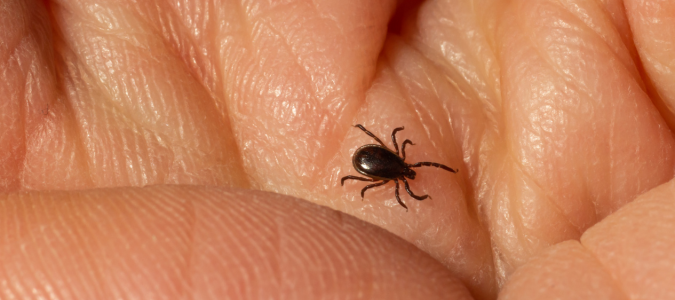Do you know how to identify a small black tick? These pests, also called deer ticks or black-legged ticks, are among the most common tick species. While they may be tiny, they can carry and transmit a host of dangerous diseases, including Lyme disease.
Small Black Tick: Identification & Control Guide
Ticks can become major annoyances for both humans and animals, so homeowners need to be able to identify these pests. The most common type of tick is a small black tick, also known as a deer tick or a black-legged tick.
You can identify this type of tick by its black legs, which is where it gets its name. Small black ticks are also smaller than other tick species. An adult is around the size of a sesame seed, while a nymph, a younger tick, is no bigger than a poppy seed.
Next, as the name suggests, most small black ticks are black. However, some can be a reddish-brown color instead. Their color also becomes redder when they are engorged with blood from a blood meal. When this happens, their usually flat bodies take on an oval shape.
Small Black Tick Risk Factors
There are several risks associated with small black ticks. The biggest concern is that they can spread a variety of diseases, such as Lyme disease.
Lyme disease symptoms include a rash, headache, fever, extreme fatigue, muscle pain, stiff joints and swollen lymph nodes. If you suspect that you have Lyme disease, it’s important to see a doctor.
Small black ticks can carry several other diseases, bacteria, parasites and viruses as well, including:
- Powassan virus disease
- Anaplasmosis
- Borrelia miyamotoi disease
- Babesiosis
How to Control Small Black Ticks
There are several ways to help control small black ticks, including keeping your lawn neat and trimmed. These pests thrive in overgrown lawns, so keeping your grass short can help remove their hiding spots.
Next, if your property backs into a wooded area, creating a barrier between your lawn and the woods that small black ticks cannot cross will help keep them out of your lawn. A layer of wood chips or gravel can create a good barrier for small black ticks.
Another thing you can try is planting tick-repelling plants in your garden, such as rosemary, chrysanthemum and lavender. Additionally, ticks often hitch a ride onto your property on the backs of rodents. Proper rodent control techniques can go a long way in preventing ticks.
When you’re outside, especially in wooded areas or tall grass, protect yourself from ticks by wearing a long-sleeved shirt, long pants and close-toed shoes.
Finally, after you, your family members, or your pets spend time outdoors, conduct a tick check to prevent a potential tick problem.
If you spot small black ticks on your property, do not hesitate to contact a pest control specialist. It’s important to control ticks as soon as possible to reduce the risk of tick-borne diseases.
Everything You Need to Know About Deer Tick Size and Control
Small black ticks, also called deer ticks, are smaller than other common tick species, including dog ticks. Adult deer ticks are only three millimeters in size, while deer tick larvae are only one millimeter in size. However, even though deer ticks are small, they still pose a considerable risk to humans and pets.
Since these pests are very small and hard to see, it’s important to follow the prevention methods listed above. Additionally, homeowners should trust professionals to control deer ticks from their property if they notice them.
To reduce the number of ticks inside your home, vacuum your floors regularly, especially your carpets, rugs and upholstered furniture. Additionally, if you suspect indoor ticks, wash your bed sheets, clothing and curtains in hot water to kill them.
Remember that ticks can often hitch a ride into your home on a rodent, so sealing up potential rodent entry points can also help control a tick problem.
Ticks can also get into your home on a pet, not to mention pose a health risk to your beloved pet. Inspect your pet for ticks on a regular basis, and use a vet-recommended tick prevention product to reduce the likelihood of a tick latching onto your pet.
Ticks do not thrive on a well-manicured lawn. Regular landscaping can help reduce these pests and deter them from coming back.
It’s important to be vigilant and proactive about deer ticks, especially since they are so small. Along with deer tick control techniques like regular cleaning and outdoor maintenance, you should work with a pest control specialist to control them.
An expert can inspect your property, identify the deer tick population and utilize professional-grade methods to kick these pests off your property. Remember that ticks can carry and transmit diseases to you, your family members and your pets, so it’s important to take a tick problem seriously and contact a pest control professional. They can help you understand how long ticks can live in a house.
How to Tell the Difference Between a Wood Tick Versus a Deer Tick
Two common types of ticks are wood ticks, pictured above, and small black ticks, which are also known as deer ticks. Both pests are very small, which makes them hard to tell apart. However, homeowners need to know which type of tick they’re dealing with on their property.
The biggest difference between a wood tick and a deer tick is their size. While both pests are small, deer ticks are smaller than wood ticks. Adult deer ticks only measure three millimeters in size, while adult deer ticks can grow to up to five millimeters.
These two tick species also have different coloration from each other. Wood ticks have an all-black lower back, while deer ticks have a distinct red lower back.
Another major difference between a wood tick and a deer tick is in their feeding style. For example, deer ticks take their time finding a desirable host and prefer to latch onto a smaller host, such as a mouse. Wood ticks, on the other hand, are much more aggressive and quick to find a host.
Wood ticks and deer ticks also prefer different types of habitats. Contrary to their names, deer ticks prefer to live in wooded areas and tall grass, while wood ticks prefer open spaces and grassy fields.
The best way to deal with a tick problem on your property, regardless of the species, is to contact a pest control specialist. An expert can identify the type of tick you’re dealing with and use their knowledge and experience to control them.
Get Rid of Ticks With Professional Help
Ticks are small pests that carry diseases that can be transmitted to you, your family and your pets. It’s crucial to be proactive about tick prevention. Keeping your home and lawn neat can go a long way in tick prevention. Additionally, wearing protective clothing and checking for ticks after you’ve been outdoors are important steps.
Contact a pest control specialist if you spot a tick on your property. An expert can identify which tick species has taken up residence in your home and control them.
ABC Can Give You Peace of Mind
Finding even a single tick on your property can be alarming. For peace of mind when it comes to ticks, contact ABC Home & Commercial Services. Our pest control professionals will create a custom tick treatment plan, so you can feel at ease. They can even help you tell the difference between tick bites and mosquito bites.



